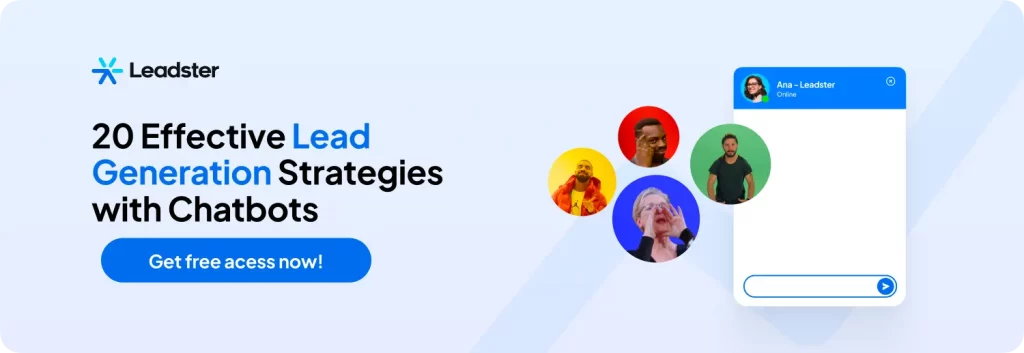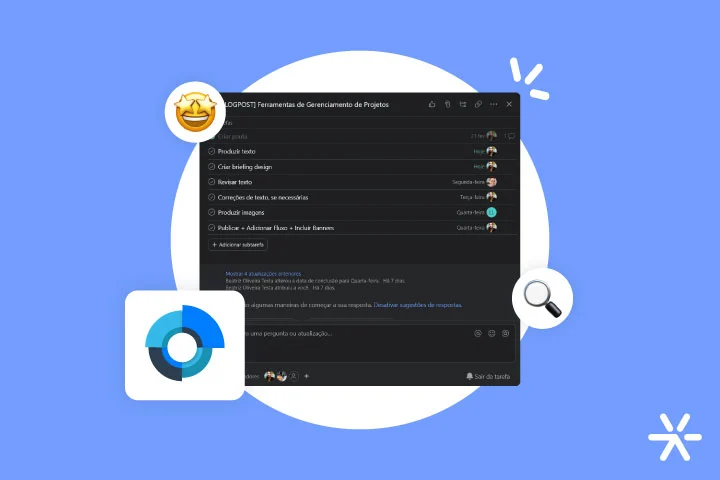Content Marketing in 2025: What Changes and Effective Strategies
Is it worth starting content marketing in 2025? Finding the answer is simple: open your Instagram, check YouTube, or ask Google something. Are you seeing the results? Those are the fruits of content marketing.
And these fruits are being harvested now, but they were planted weeks, months, or even years ago. Thinking about content marketing is this: you need to start as soon as possible to reap its long-term results.
By the way, not just in the long term. Many people think that content marketing is only about text, text, and more text, with the main focus on driving more visitors to your site via Google.
But Google is just a tool. So is YouTube, Instagram, Facebook, Reddit, LinkedIn, and any other social network. Content is everywhere.
This article is here to talk a little more about content marketing—what it is, where it’s done, and the results it delivers. We’ll also discuss how to implement the strategy and how to continuously improve it.
Starting from the beginning:
What is Content Marketing?

You might be uncertain about the concept of content marketing, but you surely know what content is.
Today, with the internet accessible to almost everyone, content is everywhere. The Oxford dictionary, in one of its definitions, describes content as:
“Topic, or a set of topics, covered in a particular book, letter, document, advertisement, etc.; subject.”
Content can be a video, a social media post, an e-book, a book, a TV show, and so on. Content is the work of gathering information and presenting it to your customer base, followers, or leads.
This content must always be relevant to those who are watching it—if it’s not, no one will watch.
Content marketing is the action of producing this content: finding your audience, coming up with ideas and keywords, producing it in a scalable way, and distributing it across the channels you have.
These channels can be many: social media, podcasts, Google through SEO (search engine optimization), YouTube, etc.
Content is produced to attract more and more people who are interested. And to turn them into an audience.
From there, it becomes easier to distribute your advertising messages since you’ll be talking to people who are interested in the same topics as you—and thus, closing new sales becomes easier.
Many people think content marketing began with the popularization of the internet. But these tactics are quite old. Television itself is a form of content marketing: the more people watch your programming, the more people watch the commercials.
And even television wasn’t the great inventor of content marketing. Here are some actions that are considered the first examples of content marketing:
What Were the First Content Marketing Actions?
The first known example of content marketing was launched in 1895 by John Deere. It was a magazine called The Furrow, aimed at farmers, which is still in circulation today.
The Furrow provided tips, weather forecasts, and articles about agriculture, and although it was produced by John Deere, it wasn’t a magazine exclusively about their products—those were featured in ads and some editorials.
However, The Furrow’s reign didn’t last long on its own. Five years later, in 1900, Michelin launched the first edition of the Michelin Guide, a publication that invented the organization of European restaurants through stars.
The best restaurants earned three stars, and those with just one star still proudly appeared in the guide.
The cover text made the content marketing intention clear: “graciously offered to motorists.” The idea was (and still is, as the guide is still published today) to help drivers find good restaurants in Paris and across Europe.
Here, the main intention of content marketing is already clear: to help ordinary people, whether they are customers of the brand or not. But the primary focus is on those who are not customers.
Imagine a farmer who doesn’t know John Deere: their first contact with the brand, instead of an ad, was through a publication that helped them with their work.
Another super interesting example to close this topic: in the U.S., what we call soap operas are known as soap operas because in 1933, Procter & Gamble invented the format as a content strategy to bring more visibility to their soap brand.
Content Marketing as an Inbound Marketing Strategy
The first efforts to understand the consumer buying journey can be attributed to Sears, at the end of the 19th century.
The American retail giant conducted research to understand what their customers needed, bought their products for resale, and distributed catalogs across the country. Deliveries were made by train.
But even though understanding the consumer buying journey is fundamental in inbound marketing, the strategy got its name and became a methodology with the birth of HubSpot in 2006.
HubSpot completely transformed the marketing world. At the time, they introduced a revolutionary concept: brands should not chase customers, interrupting them with ads or TV commercials. Customers should seek out the brand instead.
And for that to happen, content marketing is the key element. Why would customers become interested in a brand beyond the products it sells? Because, in addition to selling, it also produces content.
This content, when useful, informative, interesting, or entertaining, attracts people who often don’t even know that a brand is behind its production.
This first contact, known as attraction in the inbound sales funnel proposed by HubSpot (see below), directs potential customers’ attention to the brand. The next step is to turn them into leads, and then close the sale.
🔎 Also read: Top of Funnel - strategies and content for this sales stage.
Omnichannel Content Marketing
Back in 2006, most companies did content marketing mainly through blogs. Blogs are like the publications we mentioned earlier—The Furrow and the Michelin Guide.
By sharing their specific knowledge through a blog, brands began to receive thousands of people to their websites—the attraction stage outlined by HubSpot.
With simple forms and offering increasingly in-depth content, these brands started to convert those visitors into leads: they would leave their contact information to access new materials or request a quote.
This changed significantly with the popularization of content production on social media, YouTube, and other platforms. Instead of producing content only for the blog, brands started to spread their production, multiplying their visitors—and thus their leads.
Today, it’s like this. Blogs still exist, but content production is omnichannel, present almost everywhere people gather.
What is the Goal of Content Marketing?

By now, it’s clear that the main goal of content marketing is to generate visitors and people interested in your brand. This is usually done through an inbound marketing strategy combined with content.
But here is a great opportunity for us to break down these goals a little further, presenting some metrics you should keep an eye on for your content marketing in 2025.
Let’s talk about these:
- Increase traffic to your website;
- Generate leads;
- Build relationships with the brand;
- Increase your reach;
- Brand authority.
If you notice, the stages of the inbound sales funnel are well defined here: attract (traffic), convert and close (generate leads and sales), and delight (relationships).
Starting with the top of the funnel:
Increase Website Traffic
We’re talking about websites because today, content marketing and inbound marketing are digital strategies.
They don’t have to be, as we saw with the Michelin Guide and The Furrow, but nowadays the costs to start a digital marketing strategy are so affordable that there’s no reason to do content marketing in the classic models with print media.
Content marketing works by attracting people to your website, mainly through blogs and exclusive materials that can only be found there.
In the case of blogs, the work is done by finding topics related to your business and with significant search volume in search engines. It’s the search for keywords—platforms like SemRush, Google Keyword Planner, and Ubersuggest are used.
Finding specific keywords – like this one from the article itself, content marketing – allows you to analyze the results delivered by the tool and create a better article to rank higher on the first page of Google.
Once people visit your website, you build a loyal audience without needing to invest in ads, for example.
In other cases, like producing content for YouTube and social media, more complete materials are often made available on the website, which also increases your traffic.
🔎 Also read: Types of Marketing - 39 Strategies for Your Business
Lead generation, with people visiting your website, you have more chances to convert them into leads. And you spend less on it since you don’t need to invest in ads to generate relevant content and increase your traffic.
Typically, the process works as explained throughout the article: people land on your website via an article on your blog, a video on YouTube, etc. Then, on the website itself, they receive offers for more in-depth content, newsletters, and free subscriptions to your product.
Once they provide their information, they become leads and are one step closer to making a purchase.
The lead generation strategy in content marketing is closely linked to a blog.
We have an entire article on lead generation via blogs that’s worth reading, with a great summary by our CMO, Gustavo Luby. Check it out:
Brand Relationship
Brand relationships through content marketing occur in various ways and are not limited to the post-sales phase.
In fact, part of the lead conversion process is nurturing them via emails that often may not even discuss sales.
Here’s an example from my own inbox, from the Minimal t-shirt brand:
This happened simply because I signed up for a newsletter to receive a discount I never used.
The relationship with the brand in content marketing helps close sales – the first or subsequent ones.
Typically, this work is done via email, but there are various other ways.
A great example is Salesforce’s Trailhead platform, which showcases all the tool’s features to those who subscribed to it. They even offer certificates.
To go further and revisit old content marketing examples, we can think about Lego, which has had a magazine dedicated to showing new designs made with the toy from the ’80s to today.
🔎 Also read: Bottom of the Funnel - How to Produce Content for This Stage
Increasing Reach
Content marketing in 2025 will increase your brand’s reach to more people.
First, in the classic way: instead of only targeting people interested in your business, you will appear to people with questions related to what your product or service solves.
This alone brings a lot of traffic to your site, significantly increasing your traffic.
But with a multichannel strategy working and bringing people in, you’ll also have better performance with your social media ads and Google Ads since these platforms see many visits on your site as a strong domain authority.
Speaking of which:
Brand Authority
What if you don’t sell anything through a website? What if your brand is exclusively about retail?
Even then, a content marketing strategy in 2025 increases your brand’s authority and relevance.
For example, take a look at the work Asseptgel did on its blog during the pandemic:
By positioning itself as an authority on everything related to alcohol and hand sanitization, the brand gained greater market penetration. People searching for questions about hand sanitizer on Google get answers from the leader in the Brazilian market.
What are the Types of Content Marketing in 2025?

Content marketing in 2025 has several approaches, as we’ve already discussed in the article.
But here we want to highlight them more clearly, providing more details on content creation and going beyond its production and distribution.
There are many ways to create content. Let’s focus on the main ones here and relate them to digital marketing, where they’re most used.
But first, a little list. In this section, we’ll dive into:
- Blogs
- YouTube
- Social media
- Newsletters
- Podcasts
Let’s go?
Blogs in Content Marketing
For a long time, blogs were synonymous with content marketing. Using tools like Ubersuggest, SemRush, and Google Keyword Planner, companies would find keywords—terms searched by users on Google—and write articles to address them.
Using these tools, it’s possible to get a close estimate of how many people are searching for that keyword each month. Here’s an example for “what is content marketing”:
This is Google’s Keyword Planner, which provides results for the searched keyword and offers additional suggestions.
The job of blogs is to write an article that addresses the chosen keyword and answers the question it poses. This article you are reading is an example of this strategy being implemented.
Blog work is one of the most extensive and popular forms of content marketing, but it’s not the only one. Here are a few more to use in 2025:
YouTube
YouTube in content marketing is used in a similar way to blogs. The only catch is that there’s no tool from Google itself to find search volume for keywords.
Platforms like Ahrefs and SemRush can show keyword volume, but it’s worth being cautious with the results—they’re not always the most accurate and cannot be validated with a Google tool.
The work on YouTube is very similar to blogs, but with the difference that a video is produced. It needs to be scripted, recorded, and carefully optimized for SEO in the title and description.
Most brands that create blogs also produce videos for YouTube, often covering the same topic—the script uses the blog as a base to expand upon.
Social Media
Content production on social media is more “freeform”—you can’t research keywords like you can on blogs and YouTube.
However, it’s completely possible to search for ideas in Facebook groups, other companies’ Instagram pages, and stories from related brands. Always look for readers’ questions, compile a list, and produce content based on those.
Social media is leaning more towards video content in 2025. The reign of carousels is ending, giving way to informative reels and stories that take a more personal approach.
Newsletters
Newsletters are update emails sent to your lead database. These emails may or may not feature your products.
They are very dependent on your industry and audience. The example we shared earlier from Minimal doesn’t sell much—it’s just a motivational article directly addressing topics that interest their customer base.
Newsletters are great opportunities for lead nurturing and post-sale relationship building. They’re so popular now that LinkedIn has started offering a newsletter tool, and interactive newsletters are becoming more common.
Podcasts
Another example of highly popular content marketing for 2025 is podcasts.
It’s rare to find companies trying to sell something through podcasts; they mainly serve to increase website traffic and generate leads.
Podcasts are easy to make and require a very small investment. With a soundboard and two microphones, you can create a standout podcast in your field.

What’s New in Content Marketing in 2025?
Content marketing in 2025 is changing, but not drastically. Little by little, it’s transforming, but these changes mainly relate to the number of new platforms available to showcase your work.
The biggest change, however, is related to the article itself. There’s a new way to write articles, which we’ll dive into in this section.
Content marketing doesn’t change much because it’s a method, not a product. You’ll still need to produce content, but its format will vary as new distribution methods emerge.
In 2025, the main changes in content marketing are these:
AI-Generated Content
Take a look: let’s let artificial intelligence explain the impact it has on blog writing and content marketing in 2025.
The following article was created by ChatGPT, an AI platform capable of writing on various topics with just a click or two:
Artificial intelligence (AI) can have a significant impact on blog writing, both for authors and readers. Some ways AI can impact blog writing include:
- Content generation: Some AI software can be used to quickly and easily generate blog content. This can be helpful for authors who need to produce content in large quantities or in a short period of time. However, it is important to remember that the quality of AI-generated content can vary greatly, and human review may be necessary to ensure that the content is accurate and of high quality.
- Content editing: Some AI software can also be used to help edit blog content by suggesting grammar and style corrections. This can be helpful for authors who want to ensure their content is error-free and easy to read.
- Traffic analysis: Some AI software can be used to analyze blog traffic and provide insights into what readers are looking for. This can help authors better understand the target audience of their blogs and create more relevant content for them.
- Content personalization: Some news websites and other types of sites use AI to personalize the content displayed to each reader based on their preferences and interests. This can help ensure that readers see content most relevant to them, which can increase engagement and user satisfaction.
End of the article created by the robot. It still has several limitations and is not enough to create content on more complex subjects, but the biggest trend in content marketing for 2025 is undoubtedly the use of AI to generate outlines and scripts.
Handcrafted Content
Anything that seems too good to be true comes with some problems. This is the case with content produced by artificial intelligence: for it to rank well on Google, it needs to be better than articles written by humans, right?
And that’s where Google comes in. In 2022, its algorithm was updated to ensure that non-natural content receives less priority than content made with care, effort, and thorough research.
So, just as AI-generated content is a trend, handcrafted content is also one.
Many brands face significant challenges when generating content through platforms like ChatGPT. If there isn’t much information on the subject online, it often won’t get the facts right.
Additionally, the fierce competition to appear on Google’s first pages requires increasingly in-depth and longer articles.
Therefore, although AI-generated content is a trend, handcrafted content, with thorough research, is also on the rise.
Video Content
Any content on social media today performs better through video. Not too long ago, everyone in marketing was talking about how Instagram was giving more visibility to reels than photos, remember?
It was true. But today, in content marketing for 2025, it’s less about what Instagram “commands” the algorithm to do and more about what people want to see.
Users have already made it clear they prefer videos. Even podcasts get more views on YouTube, where episodes have videos, than on platforms like Spotify and Google Podcasts.
Creating video content isn’t just a trend for 2025—it’s been a trend for a long time and will likely remain one for many years.
More Intensive Use of Social Media
As we’ve seen so far, content marketing isn’t “restricted” to blogs.
In fact, it’s everywhere. Content production will never be tied to just one medium because that would defeat its purpose and destroy its scalability.
The thing is, content marketing in 2025 will solidify as the ideal methodology for production across most social media platforms.
Don’t get me wrong: this is already happening today, and it’s happening right now. But only by those who understand the true potential of social media.
For example: clothing stores are no longer just posting pictures of their items. They’re posting memes, followed by photos of their clothes in a carousel.
Content marketing on social media is still quite weak. It’s popular, many brands are putting their principles into practice, but it is still not the standard.
Companies are hiring journalists and specialists in their areas to produce increasingly in-depth content, first focusing on education, then on sales.
Integrated Content
It’s no longer enough to just create content on your blog and call it a day.
Everything we’ve discussed in this article shows that content marketing in 2025 will become even more competitive than it already is.
The main culprit for this competition is AI. Previously, there was a significant barrier for small companies to enter Google: hiring a copywriter.
Today, that barrier no longer exists. Any company can create content by the dozens using ChatGPT.
This makes the environment much more competitive, and the focus shifts from just writing articles to an overall content strategy.
Here at Leadster, for example, we always launch integrated materials. An e-book turns into a blog post and a webinar. The webinar turns into several YouTube videos. These videos are inserted back into multiple blogs, which bring banners for the original material.
And, of course, using chatbots as part of the conversion strategy.
🤿 Dive deeper: Articles for Chatbots — 59 Examples Focused on Conversion
This is the type of work you need to do. Every content idea in 2025 cannot be singular. The right approach is to think in terms of ideas, in the plural.
This is because no one consumes content from just one source anymore. People read blogs, read social media posts, watch videos — in some cases, all of this simultaneously.
The idea that achieving results with content is an easy task to systematize is gone. We’re producing content for real people in 2025.
Flood of Low-Quality Content
With AI firmly established in the market, including dozens of AI tools for content production, we can’t ignore the downsides.
That is, it’s no longer enough to just look at the positives of AI without considering its negatives. And the biggest negative is this: if everyone can produce low-quality content using AI, many people are already doing so.
This is humanity’s ultimate rule. If it’s accessible to everyone, many will do it the right way, but many will also do it the wrong way.
We will go through 2025 in this situation. Many people producing a lot of low-quality content.
It’s our responsibility to rethink content marketing in 2025 as a whole, aiming to avoid this problem.
But there’s still one more issue:
Drastic Changes in SERPs
In 2025, SERPs will undergo some drastic changes involving AI.
Google and Bing are already testing their direct search functionalities using AI, including AI-generated results on the search pages.
Bing doesn’t yet have this functionality in Brazil, but you can already choose to search through ChatGPT.
Google hasn’t yet rolled out its SERP powered by BARD in Brazil, but when it does, it will look something like this:
This is already a problem for content production aimed at Google in Brazil today, before we even dream of AI-powered SERPs — the snippets ensure that more and more users stay on Google itself.
Content marketing in 2025 will be even more complicated in the blog environment because of this.
We’ve already talked a lot about what (probably) will happen. But what can we do to deal with this reality?
That’s what the next section is about. Join me:
What are the top Trends for Content Marketing in 2025?

Talking about annual trends nowadays has a different tone than a few years ago.
We used to talk about how new technologies would improve all of our work, and most of the time, we were right.
But now, with AI being the main topic of content marketing trends for 2025, the conversation has become a little darker. 🥲
AIs will make our work easier. But at the same time, they will open up some more complicated precedents.
To truly understand content marketing in 2025, we need to address all these points. And that’s what we’re going to do now.
Come with me:
Analyzing Google’s Latest Update
Google’s most recent update, implemented in March 2025, heavily targeted content considered by the platform as Spam and what the company deems “non-original and irrelevant.”
This was a Core Update, the largest category of updates Google makes, directly affecting its algorithm.
With this update, Google intends to deindex up to 40% of websites that fall under these criteria, removing not only specific pages but entire websites from the search engine.
Please note: this means removal from the search engine, not from the entire internet! However, for digital marketing, not being on Google is as if you’re not on the internet at all.
Be very careful with one point: what we understand as “spam” may differ from what Google understands.
A common practice in blogs to generate leads is link building. You ask another brand for a link in exchange for another link.
This is Spam for Google. If you buy the link, it’s even more Spam.
Of course, this type of practice, despite causing penalties (in some cases), won’t get your website deindexed overnight.
But if you buy links, produce a massive amount of content through AI, or create sites solely to index a keyword but don’t maintain them, it’s likely that you will experience traffic drops throughout the year.
And without warning. Simply put: goodbye, traffic!
I strongly recommend reading the full update article to understand what Google is prioritizing. Throughout the next sections, we’ll discuss some of these priorities.
Humans Working with AI
“Oh, so you can’t use AI or Google will penalize you?” — Of course not!
In the first Helpful Content update Google made, a few weeks after the launch of ChatGPT, it explicitly stated that it was against the use of AIs in search results.
In other words: articles created by AI, if identified as such, would face penalties.
But in the next update, that conversation changed and softened. From that point on, Google replaced “AI-generated content” with “irrelevant and spam content.”
In other words: AI-generated articles are approved by Google. The problem is that you cannot fall into the category of spam or useless/irrelevant content.
This is done by working with a copywriter who understands how to use AI, generates the right prompts, and revises the final result.
This is what we’re seeing most in 2025 in content marketing: people truly working alongside AI to produce content, and always together.
Showcasing the Evidence of Human Work
But there are also those brands that don’t want to use AI in content production, and that’s perfectly fine too.
In fact, this is another big trend in Content Marketing for 2025 — the pride of having content produced by humans, with not a single line written by AI.
I get it, AI has great characteristics for content production. But, in some cases, it undermines the very notion the brand is trying to convey.
Brands that emphasize a more human side, aiming to connect with people through their content, can’t do that with AI. It goes against their purpose and commitment.
If this is your case, look for strategies to highlight that this content was written by a person.
Leave a note on the blog or include the author’s photo with a brief description, and make sure to announce on your other media channels that your content is made by people.
There’s nothing wrong with using AI to create content, but it all depends on who you are and what you do.
Making Your Content Stand Out with Interactive Resources
Once it was said that content is king. Then it was said that content isn’t the king, it’s the whole kingdom.
Now, content isn’t even the king or the kingdom: it’s the entire continent. And the surrounding sea, rivers, forests, and even us.
With AI emerging, we will see a drastic increase in low-quality content being produced. Google will try to curb this, but it won’t succeed. Google rarely gets it right 😅
Thus, you need to prepare now to completely transform your content, avoiding as much as possible the walls of text and incorporating different resources that will give you more visibility.
And they don’t even need to be very complex. Here’s a quick list:
- Videos already published;
- Screenshots from other articles by other brands, properly linked;
- Suggestions for further reading;
- Rich materials and Lead Magnets that make sense with the content;
- Testimonials from experts within your own company;
- Case studies and customer stories;
- Images created specifically for that content, like infographics.
The list can be as long as you like, but with one key focus: making it easier for users to navigate the article and increasing engagement.
Huge Focus on E-E-A-T
As we discussed earlier, AI will dominate Google, and the search engine is not pleased with that.
Look: it doesn’t have an issue with AI-generated content, but its bias has been clear since the first Helpful Content update: Google prefers useful content, and useful content follows E-E-A-T, which was previously just E-A-T.
Let’s better understand what this acronym means?
- First E: Expertise;
- Second E: Experience;
- A: Authority;
- T: Trustworthiness.
These are the main points Google considers when ranking any content.
Expertise, trustworthiness, and authority are all related to your business. If you’re a marketing agency, writing about bakeries won’t get you ranked.
Alright, extreme example — if you’re a digital marketing agency, you’ll find it harder to write about Outbound Marketing than Inbound Marketing.
🔎 Also Read: Types of Marketing — 39 Strategies for Your Business
Experience is related to the optimization of your website and how easy it is for users to navigate through it.
At this point, AI also comes in. What experience will someone have accessing a website full of content generated by AI and with no revisions?
Such articles become irrelevant.
Using AIs for Analytics
Content marketing in 2025 doesn’t only use AI in production. It’s also widely utilized in the more operational side, especially in analyzing, interpreting, and creating reports from your results with Analytics.
Yes, Google Analytics itself provides everything you need to know about your website. But at the same time, it’s a bit more complicated to use, so you’ll need to learn how to use it or teach someone.
Or, of course, hire a specialist for this task, like a marketing manager.
Today, there are AIs to do this work, usually integrating data from Analytics into more operational tasks like keyword research, creating editorial calendars, creating reports, etc.
We have an article that brings some examples of these tools. Check it out below:
➡️ 21 AI Apps for Mobile and Desktop
Focus on CTR in the SERPs
Still talking about Analytics, one of the main concerns for those working with content marketing and SEO in 2025 is analyzing your CTR (click-through rate) in the search result pages.
CTR is a marketing metric that stands for click-through rate — how many people saw your content and clicked on it.
Most content analyses are based on simple KPIs (Key Performance Indicators): the number of visitors.
But this KPI doesn’t tell the whole story. For example: you can have 10,000 visitors per month on a single page of your website and a low CTR at the same time.
If you had a high CTR, you’d have well more than 10,000 visitors.
It’s especially important to analyze this metric now due to the centralization of content in the SERPs themselves.
Google doesn’t want users to leave its results page, and it’s actively working to achieve this goal through snippets and generative AI results.
Tracking this index is important so you understand how this Google priority is affecting your content.
How to Start Doing Content Marketing in 2025?

Your brand doesn’t do content marketing yet? Then you’re wasting time. All the traffic and leads you could be generating today and aren’t, come from this lack of content.
It’s very likely that, starting in 2025, you won’t see big results in the same year. But in 2025, you won’t want to look back and think: “Wow, I should have invested.”
In this article, we’ll show you everything you need to know to start a winning content marketing strategy and become a reference in your niche. Check it out:
Budget
The quality, frequency, and relevance of your content marketing in 2025 directly depend on the budget you allocate to the area.
You’ll need professionals and to spend a little on some essential tools to scale your operation.
And we’re on a growth trend. According to HubSpot via Deloitte, investment in marketing is twice as high as it was in 2012 — the highest level in history:
The content sector today is one of the most expensive in the marketing department of startups and companies that prioritize digital. Good content has the power to put you ahead of most of your competitors without making you spend excessively on ads.
So, prioritize at least half of your entire marketing budget for content. The results it yields are very significant and won’t disappear anytime soon — plus, they don’t require ongoing maintenance costs.
It’s the difference between paid traffic and organic traffic. Here’s an example to understand it better:
A YouTube channel generates views organically, without you needing to pay. If the videos are interesting and have good demand, they won’t stop attracting visitors overnight — on the contrary, they will keep attracting more.
It’s not like a Google Ads ad or a TV commercial, where if you stop spending, you stop getting visitors or views.
The same goes for a blog. You invest per article, not per period. And the articles are long-lasting. This is the magic of content marketing.
Strategy
A large portion of this investment needs to be made at the beginning of your operation to ensure you have a great content strategy before you start producing.
Finding your audience, having a content plan, knowing which articles need more attention and which videos should be filmed in advance is essential for content marketing in 2025.
Don’t leave the strategy for later. Typically, the steps to create one are as follows:
- Investigate and define your target audience;
- Create a persona;
- Define your tone of voice;
- Research topics and keywords;
- Start production;
- Measure your success using Google Analytics.
Execution
To have a solid content team, you’ll need at least the following collaborators:
- SEO specialist to find keywords;
- Analyst to write briefings and analyze results;
- Copywriters to write the article;
- Proofreaders to review them;
- Social media managers to publish on social networks.
The workflow will revolve around these people. Without them, the execution of your content marketing strategy in 2025 won’t shine as you would like and will encounter some setbacks.
It’s very important during the execution of your content strategy to analyze the work being done by your competitors. You’re always competing with them for space, so knowing how your article needs to be beforehand is crucial to achieving the best results.
Ready to Start your Content Marketing Strategy in 2025?
I hope this article has helped you understand the importance of content marketing and how to start producing articles, videos, pieces, and whatever else you plan to include in your strategy!
But there’s something very important you’ll also need to start thinking about: what to do with the traffic your website will get.
How will you handle these leads? How do you communicate with all of them and guide them through your sales funnel?
The best way is through a platform like Leadster. Our chatbot automatically offers conversion opportunities for each visitor.
How about learning more about what we can offer? Try it for free!








